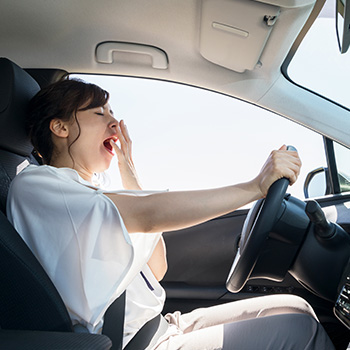Drowsy Driving Dangers & Statistics
In the wake of a terrible car accident that left comedian Tracy Morgan critically injured, investigators learned that the driver responsible for the crash (WalMart truck driver Kevin Roper) had not slept in the entire 24 hours prior to the crash. This brings to light a problem that can be as dangerous as drunk driving only without the social stigma and publicity.
 Drowsy driving is a predictable, preventable tragedy that leads to more than 100,000 crashes, 40,000 injuries and 1,500 deaths each year. Why is sleepiness so dangerous? A study by researchers in Australia revealed that being awake for 18 hours is akin to driving with a BAC of .05, raising to an equivalent BAC impairment of .10 after being awake for 24 hours. A study by the AAA Foundation for Traffic Safety also showed that adults sleeping only six to seven hours a night are twice as likely to be involved in a crash as those sleeping 8 hours or more, and people sleeping less than 5 hours are four to five times as likely to be involved in a crash.
Drowsy driving is a predictable, preventable tragedy that leads to more than 100,000 crashes, 40,000 injuries and 1,500 deaths each year. Why is sleepiness so dangerous? A study by researchers in Australia revealed that being awake for 18 hours is akin to driving with a BAC of .05, raising to an equivalent BAC impairment of .10 after being awake for 24 hours. A study by the AAA Foundation for Traffic Safety also showed that adults sleeping only six to seven hours a night are twice as likely to be involved in a crash as those sleeping 8 hours or more, and people sleeping less than 5 hours are four to five times as likely to be involved in a crash.
While commercial drivers like Roper represent a large portion of at-risk individuals (most crashes or near misses occur between 4:00am and 6:00am), other individuals affected may include night shift workers, drivers with sleep disorders or drivers who take sleep medications or antihistamines. Adults between 18 and 29 are the most likely to drive while drowsy compared to other age groups, and men are almost twice as likely as women to fall asleep while driving.
That said, literally anyone on the road can suffer from drowsiness while driving, so it is vital to be aware of warning signs and to prepare yourself to be fully alert while driving.
Recognizing Drowsy Driving
The National Sleep Foundation has compiled a few warning signs that should let you know to stop and rest.
- Difficulty focusing
- Frequent blinking, yawning, or rubbing eyes
- Daydreaming, disconnected thoughts
- Trouble remembering the past few miles driven
- Trouble keeping head up
- Drifting from your lane
- Missing exits or traffic signs
- Hitting a shoulder rumble strip
Drowsy Driving Countermeasures
Before Hitting The Road
- Get adequate sleep – most adults need 7-8 hours and teens can need 9-10
- Schedule proper breaks – about every 100 miles or 2 hours during long trips
- Arrange for a travel companion – someone to talk to you and share the driving
- If you have a known sleep disorder, remain under medical care and discuss driving with your doctor
- Avoid alcohol and sedating medications – check labels and talk to your doctor
On The Road
- Stop driving
- Take a nap
- Drink caffeinated beverages
- Pay attention to warning signs
Categorized in: Driving, Safety Tips
